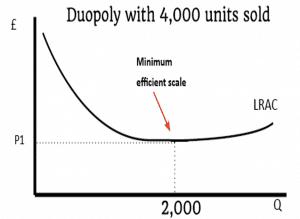
What Is a Duopoly?
A duopoly is a market structure that is dominated by two firms, while a pure duopoly is a market where only two firms exist. Most duopolies, however, are markets where the two largest firms control more than 70% of the market share.
The Characteristics of a Duopoly
- Strong barriers to market entry, such as brand loyalty (Pepsi vs. Coca-Cola)
- Significant economies of scale which cater to a small amount of firms (for example, Boeing and Airbus, which are airline manufacturers)
In the industry charted above, suppose that the industry demand is 4,000 units sold. If the minimum efficient scale is 2,000 units, then the most efficient number of firms is two, which means that the market is a duopoly. In contrast, if four firms were producing 1,000 units each, the average costs would increase as a result.
- Firms may compete against each other on price. However, they could also seek to collude or cooperate with each other through either a formal agreement or tactically. The collusion strategy may vary depending on the nature of the industry. For instance, Pepsi and Coca-Cola compete with their brand images. Advertising takes up a large portion of their revenue. Meanwhile, their price competition is somewhat muted. Another example is the relationship between Boeing and Airbus. When Airbus was founded in 1970, airline manufacturing became much more competitive. Airlines could now choose between two companies, rather than automatically going to Boeing. This led to a larger choice of goods, as well as more price competition between the two airline manufacturers.
- Duopolies are typically very profitable industries. They commonly have an outcome that’s similar to that of a monopoly. This includes a degree of allocative inefficiency, along with price higher than marginal cost. Lower average costs and economies of scale can work to offset the drawbacks that come with higher prices.
The Relationship Between a Duopoly and a Monopoly
Duopolies and monopolies (in which one firm dominates the market) are very similar. A general definition of a monopoly is a firm that holds more than a quarter of the market share. However, in a duopoly, where an industry has two firms, both of the firms hold significant monopoly power.
The Relationship Between a Duopoly and an Oligopoly
In an oligopoly, several firms dominate the market. The criteria for a market to be considered an oligopoly is to have five firms and a concentration ratio of more than 50%. Meanwhile, a duopoly is considered to be a more concentrated form of an oligopoly.
Examples of Duopolies
Mastercard and Visa
These two companies process credit card transactions, and they take up 80-90% of the market share. This allows Mastercard and Visa to gain extremely profitable commission on payment processing. As Reuters explained in 2020, Visa held 60% of the market share, while Mastercard held 30% and American Express held 8.5%. The extremely high market shares of Mastercard and Visa caused the EU Commission to launch an investigation concerning monopoly power. This investigation culminated with the EU Commission forcing both companies to cut fees for tourists paying in other countries.
Android and Apple
These two mobile operating systems account for a whopping 97.3% of the market. Meanwhile, their rivals account for only a small 2.7% of the market share.
Airbus and Boeing
Airbus and Boeing, both highly successful airline production companies, form a classic duopoly due to their domination of the market. Airbus and Boeing together own 99% of the commercial production market. In the past, Boeing enjoyed a monopoly until Airbus was founded in 1970; by the 1990s, the two had become major rivals. Considering the airline manufacturing industry, which has substantial economies of scale as well as high fixed costs, it wouldn’t be practical to have multiple competitors competing for their share of the market.
British Airways and Easyjet
These two airline companies both offer direct flights from London to Edinburgh, creating a pure duopoly in the market of direct flights.
Pepsi and Coca-Cola
According to a 2018 study by Statista, Pepsi held 29% of the cola market, while Coca-Cola held 43%, giving this duopoly a two-firm concentration ratio of 68%.
Two Formal Duopoly Models
Cournot Model
This model is based on economist Antoine Augustin Cournot and his investigation of the duopoly in French spring water. The Cournot Model assumes that firms have market power, that they act rationally, that they do not cooperate, and that they produce a homogenous product. Therefore, the firms’ main form of competition is choosing the optimal output. Based on his investigation, Cournot concluded that firms in a duopoly would act as a monopolist by setting a profit that maximizes output, as well as setting a price that doesn’t give an incentive to start a price war. In the Cournot model, it’s argued that there is stable equilibrium in a duopoly.
Bertrand Competition
Joseph Louis François Bertrand developed the Bertrand Competition, another economic model that deals with duopolies. In the Bertrand Competition, Bertrand states that in an oligopoly with a homogenous product, it’s most likely that the two firms will set their price equal to marginal cost. In the case of a firm raising prices above marginal cost, that firm would then lose all of their market share to the cheaper firm. They would be forced to reduce their price until p=mc (market price = marginal cost). In the Bertrand Competition model, there is no assumption of cooperation, market power, or homogenous product. Bertrand Competition assumes that there aren’t any capacity constraints and that firms can readily increase their output.



